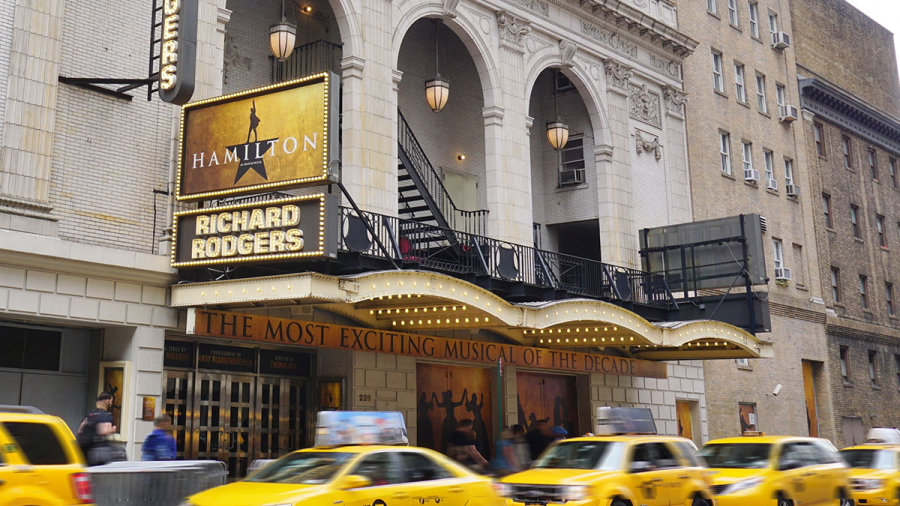Hamilton: A Musical of the People, by the People, for the People
A single black star stands out from a golden poster, illuminated by marquee lights as yellow as the taxis driving by. Overlaid on top of the star in bold white letters: Hamilton: An American Musical.
A single black star stands out from a golden poster, illuminated by marquee lights as yellow as the taxis driving by. Overlaid on top of the star in bold white letters: Hamilton: An American Musical.
Hamilton tells the story of young Caribbean immigrant Alexander Hamilton, on his tumultuous journey to go from a soldier in the Revolutionary War, to the very first secretary of the treasury of the United States. Constantly competing against Aaron Burr, Hamilton is a talented writer, speaker, and lawyer, though often infusing too much emotion into his arguments. Hot-headed and ambitious, Hamilton takes risks at every point in his life, leaving a legacy of both scandal and great achievement. However, before the wildly popular musical, not many people knew much about Hamilton, let alone who he was.
On first impression, one can hardly imagine how the wildly differing components of Hamilton could form a cohesive story. First of all, it’s a historical narrative told almost entirely through rap, R&B, and hip-hop songs. The stage is set with two levels of wooden scaffolding, which hardly seem adequate to depict the variety of settings. The main cast members are primarily people of color, but they all portray historically white characters. Yet it is through these lenses of unconventionality that one can truly attain a closer look at the nuances of history.
Combining modern music with the origins of our country, Hamilton appeals to a broader audience, building a bridge between the archaic anecdotes of the past and the fast-paced energy of the present. Lively rap songs embody the courage and vigor of the American Revolution, while King George III’s songs use classical instruments such as the harpsichord to mirror the past. The memorable show tunes bind to one’s mind in a way no spoken dialogue could. The energetic power anthem of “The Schuyler Sisters” brings to mind modern feminism and emphasizes the strength and spirit of women then and now. The words of four, young, ambitious, American men “I may not live to see our glory, but I will gladly join the fight,” echoes the resolute words of each person protesting against racism and sexism in the streets today.
From the robust, almost angry song of “Yorktown” to the bittersweet ballad of “Dear Theodosia”, each song is filled with profound emotion. The hopeful words, “And when our children tell our story, they’ll tell the story of tonight,” stir up the weary mind like the wind lifts the leaves once fallen from the tree. As Angelica Schuyler sings, “We hold these truths to be self-evident / That all men are created equal / And when I meet Thomas Jefferson / I’mma compel him to include women in the sequel,” every beat of music makes the heart beat more boldly, unafraid of the world outside. Each song sparks emotion until a fire is burning in the soul, a fire of passion and determination.
Not only do the catchy songs conceal deep emotion, the seemingly simple set veils a dynamic stage. Two concentric turntables in the center of the stage, as well as a moving staircase and candlelights on wheeled tables, transform the stage from the bow of a ship to a ballroom to a grassy hill set for a duel. Subtle details are hidden in each of these props. The turntables epitomize the turning of time, both backward and forward, as well as the relationship between rivals Hamilton and Burr, as their lives spin around one another.
The ensemble seamlessly forms the background to every scene, dancing gracefully as they push props on and off stage. When these elegant, flowing movements are combined with the powerful vocals, they make for a stunning, dynamic experience.
The simple, yet eye-catching costumes add yet another layer to the complexity of detail in the musical. While still maintaining the style of the 18th and 19th centuries, the costumes are made to accommodate the movement of the actors. The ensemble wears all beige and black outfits, while the main characters feature vibrant and characteristic colors. Some, such as the three Schuyler sisters, wear the same color scheme throughout the musical. Despite the uniformity of the costumes, the racially diverse cast brings richer and more colorful perspectives to the stage.
Alexander Hamilton was likely a slaveholder, and his wife’s rich family got their money from a slave-trading business. The musical has been criticized for overlooking this great flaw of Hamilton’s. However, producer, composer, and actor Lin-Manuel Miranda decided to focus on the immigrant in Hamilton, telling the story of American opportunity through the eyes of an American founding father. Through Hamilton, Miranda was also able to literally give a stage to more under-represented groups of actors, especially people of color. Whether it’s a black Aaron Burr or a Puerto Rican Alexander Hamilton, Hamilton’s diverse cast allows us to see all aspects of American culture. Even though the founding fathers were all white men, America is so much more than that, and many other people play a role in our country’s history. By seeing through the eyes of people of color, of immigrants, of men and women alike, we gain a greater understanding of what America stands for.
Hamilton weaves together the colorful threads of past, present, and future into a beautiful, bold, honest, and hopeful picture of America.

